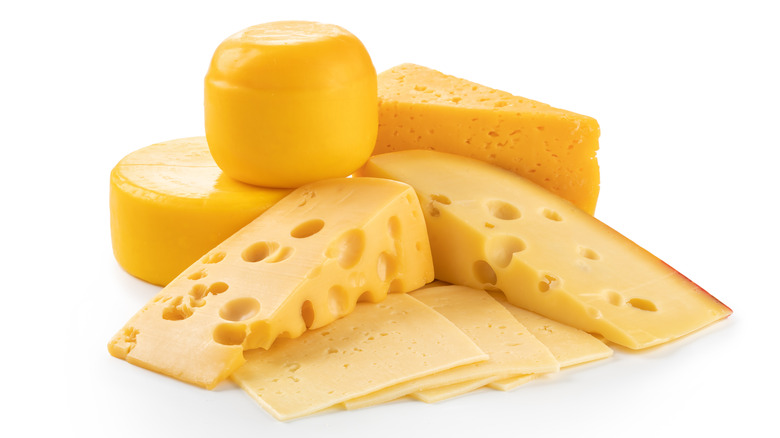The Origins Of Swiss Cheese
You may not be thinking that much about history or geography as you are making a sandwich, but as you fish the ingredients out of your fridge, a name as generic as Swiss cheese should raise your eyebrows. Like American, cheese names that impressively broad only serve to obscure, not describe, and often mask more specific origins.
Europe produces a truly extraordinary variety of cheeses. For example, there are more than 600 styles produced in Germany alone, according to Cook's Info, so to think Switzerland would be defined by one type of cheese is pretty absurd. This is the part of the world that produced fondue, of course, so you know these people really love their cheese.
In fact, you are probably already familiar with some of the more famous Swiss cheese styles that aren't explicitly named "Swiss cheese." Gruyère is a world-famous protected origin cheese, and despite its common presence in your croque monsieur, Food & Wine will tell you it's made in Switzerland. The Swiss also produce the unmistakable Raclette, a creamy, pungent cheese you may have seen heated up and scraped straight off the wheel onto bread or sausages.
So if Switzerland has such a significant cheesemaking tradition, then why do we call this one cheese Swiss, and how did it get that name?
Swiss cheese started its history as emmental
When you think Swiss cheese, the first image that comes to mind are those big, irregular holes, and that means the cheese you are really thinking of is Emmental. According to The Spruce Eats, Emmental is a mountain cheese from the Swiss region of Bern, around a river called the Emme.
It's a grass-fed cow's milk cheese that has the same holes and buttery texture we associate with Swiss cheese. Emmental does have a stronger flavor than you likely associate with Swiss, but due to its great melting properties, you can still use it in many of the same ways, whether that be in a Cuban or a creamy mac and cheese.
The reason why Emmental was rechristened Swiss in the U.S. isn't nefarious; it was just the result of immigration. Wisconsin Cheese says Swiss immigrants started producing cheese in the style of their home country for American consumers in the late 19th century, and its surging popularity led to the rebrand. This also led to the creation of the more Americanized baby Swiss, which is aged even less than Swiss and thus even more creamy and meltable.
Swiss cheese is a classic American food success story, as an old style adapts and finds a new generation of fans in a new home, no different from the hamburger. So next time you layer in a few slices for your patty melt you can celebrate both Switzerland and the U.S. at the same time.

